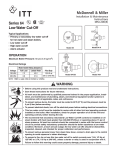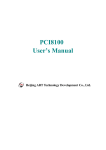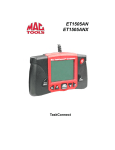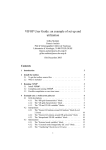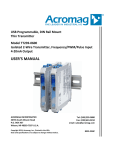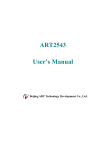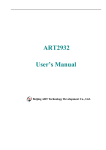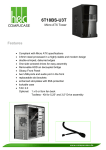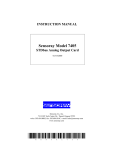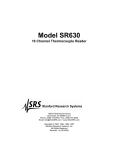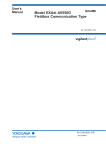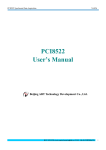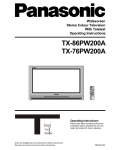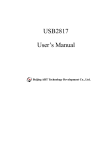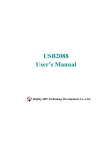Download ART2750 User`s Manual
Transcript
ART2750 User’s Manual Beijing ART Technology Development Co., Ltd. Beijing ART Technology Development Co., Ltd. V6.1.18 Contents Contents ................................................................................................................................................................................2 Chapter 1 Overview ..............................................................................................................................................................3 Chapter 2 Components Layout Diagram and a Brief Description .......................................................................................5 2.1 The Main Component Layout Diagram ..................................................................................................................5 2.2 The Function Description for the Main Component ...............................................................................................5 2.2.1 Signal Input and Output Connectors ............................................................................................................5 2.2.2 Potentiometer ...............................................................................................................................................5 2.2.3 Jumper..........................................................................................................................................................6 2.2.4 Board Base Address Selection .....................................................................................................................6 2.2.5 Indicator .......................................................................................................................................................6 Chapter 3 Signal Connectors.................................................................................................................................................7 3.1 Analog Input/Output Interface ................................................................................................................................7 3.2 Analog Signal Connector ........................................................................................................................................7 3.3 Digital Input/Output Connector ..............................................................................................................................8 Chapter 4 Connection Ways for Input and Output................................................................................................................9 4.1 Analog Output Connection......................................................................................................................................9 4.2 External Trigger Signal (ART) Connection ............................................................................................................9 4.3 Clock input/Output and Digital Trigger Signal Connection....................................................................................9 4.4 Methods of Realizing the Multi-card Synchronization ...........................................................................................9 Chapter5 Address Allocation Table.....................................................................................................................................11 Chapter 6 Notes and Warranty Policy ................................................................................................................................14 6.1 Notes .....................................................................................................................................................................14 6.2 Analog Signal Output Calibration.........................................................................................................................14 8.3 Warranty Policy.....................................................................................................................................................14 Products Rapid Installation and Self-check ........................................................................................................................16 Rapid Installation ........................................................................................................................................................16 Self-check ...................................................................................................................................................................16 Delete Wrong Installation ...........................................................................................................................................16 BUY ONLINE at art-control.com/englishs or CALL+86-10-51289836(CN) 2 Beijing ART Technology Development Co., Ltd. V6.1.18 Chapter 1 Overview ART2750 is an arbitrary waveform generator card based on PC104 bus, can be connected to the computer's PC104 interface to constitute the laboratory, product quality inspection center and other areas of data acquisition, waveform analysis and processing system. And also can constitute industrial process monitoring system. Its main applications are: ■ Electronic Product Quality Testing ■ Signal acquisition ■ Process Control ■ Servo Control Unpacking Checklist Check the shipping carton for any damage. If the shipping carton and contents are damaged, notify the local dealer or sales for a replacement. Retain the shipping carton and packing material for inspection by the dealer. Check for the following items in the package. If there are any missing items, contact your local dealer or sales. ¾ Art2750 Data Acquisition Board ¾ ART Disk a) user’s manual (pdf) b) drive c) catalog ¾ Warranty Card DA Arbitrary Waveform Output Function ¾ ¾ ¾ ¾ ¾ ¾ ¾ ¾ ¾ ¾ ¾ ¾ ¾ ¾ ¾ ¾ ¾ Converter Type: AD7845 Output Range: 0~10V, ±5V, ±10V Resolution: 12-bit Output Point Rate (Frequency): up to 1MHz (1us/point). software adjustable, adjustable range: 0.01Hz ~ 1MHz Analog Signal Bandwidth: 0~50KHz Number of Channels: 4 Output Impedance: 50Ω or 75Ω (jumper setting) Trigger Source: software independent trigger source, software synchronization trigger source, hardware analog trigger source (ATR), hardware digital trigger source (DTR) Trigger Level: ±10V (software setting) Trigger Direction (TriggerDir): negative trigger, positive trigger, either positive or negative trigger Clock Source: internal clock and external clock (CLINK) (software selectable) Memory Depth: 1M word (point) RAM Memory Work Flag: DA conversion flag, trigger flag, the current segment number, the current segment address, the current segment number of cycles, the current total number of cycles Data Transmission: program mode Gain : 1time and 2 times DA Set-up Time: ≤600ns Non-linear Error: 0.5LSB BUY ONLINE at art-control.com/englishs or CALL+86-10-51289836(CN) 3 Beijing ART Technology Development Co., Ltd. V6.1.18 Other Features ¾ ¾ On-board Clock Oscillator: 40MHz Dimension: 102mm (L) * 127mm (W) * 16mm (H) 102mm (L) * 135mm (W) * 16mm (H) (including the interface) BUY ONLINE at art-control.com/englishs or CALL+86-10-51289836(CN) 4 Beijing ART Technology Development Co., Ltd. V6.1.18 Chapter 2 Components Layout Diagram and a Brief Description 2.1 The Main Component Layout Diagram 2.2 The Function Description for the Main Component 2.2.1 Signal Input and Output Connectors P1: Digital signal input/output connector P2: Analog signal output connector AO0~AO3: Analog output interface ATR: Analog trigger signal input interface 2.2.2 Potentiometer RP2, RP3, RP8, RP9: AO0~AO3 analog output zero-point adjustment BUY ONLINE at art-control.com/englishs or CALL+86-10-51289836(CN) 5 Beijing ART Technology Development Co., Ltd. V6.1.18 RP6: AO0 analog output 0~10V, ±5V full-scale adjustment RP7: AO1 analog output 0~10V, ±5V full-scale adjustment RP12: AO2 analog output 0~10V, ±5V full-scale adjustment RP13: AO3 analog output 0~10V, ±5V full-scale adjustment RP4: AO0 analog output ±10V full-scale adjustment RP5: AO1 analog output ±10V full-scale adjustment RP10: AO2 analog output ±10V full-scale adjustment RP11: AO3 analog output ±10V full-scale adjustment 2.2.3 Jumper JP1, JP2, JP3, JP4: AO0 ~ AO3 analog output impedance selection, when shorted the 1-2 pins of the jumpers, the output impedance is 50Ω, and when 2-3pins are shorted, the output impedance is 75Ω. 2.2.4 Board Base Address Selection The base addresses is300H (fixes address) 2.2.5 Indicator -5 VA: -5V analog power indicator LED_+5VA: +5V analog power indicator +5 VD: +5V digital power indicator +3.3 VD: +3.3V digital power indicator LEDRAM4: AO3 analog output channel RAM status indicator LEDRAM3: AO2 analog output channel RAM status indicator LEDRAM2: AO1 analog output channel RAM status indicator LEDRAM1: AO0 analog output channel RAM status indicator BUY ONLINE at art-control.com/englishs or CALL+86-10-51289836(CN) 6 Beijing ART Technology Development Co., Ltd. V6.1.18 Chapter 3 Signal Connectors 3.1 Analog Input/Output Interface ART2750 has five signal interface, AO0, AO1, AO2, AO3, and ATR signal port, AO0, AO1, AO2, AO3 are analog output ports of the 4 channels DA, corresponding to the DAOUTBOARD0~DAOUTBOARD3 pins of the P2, ATR is analog trigger signal input port, corresponding to the ATRIN pin of the P2. 3.2 Analog Signal Connector P2: 12-pin definition AGND 12 6 AGND AGND 11 5 ATRIN AGND 10 4 DAOUTBOARD3 AGND 9 3 DAOUTBOARD2 AGND 8 2 DAOUTBOARD1 AGND 7 1 DAOUTBOARD0 Pin definition Signal Name Type Definition DAOUTBOARD0~DAOUTBOARD3 Output Analog output pins ATRIN Input Analog trigger signal input port AGND GND Analog ground BUY ONLINE at art-control.com/englishs or CALL+86-10-51289836(CN) 7 Beijing ART Technology Development Co., Ltd. V6.1.18 3.3 Digital Input/Output Connector P1: 20-pin definition +5V 1 2 +5V NC 3 4 NC NC 5 6 NC NC 7 NC NC 9 8 10 DGND 11 12 DGND CLKOUT 13 CLKIN 15 14 DGND 16 DGND DTR 17 18 DGND DGND 19 20 DGND NC Pin definition Signal Name Type Definition CLKIN Input External clock input pin CLKOUT Output Internal clock output pin DTR Input External digital trigger signal input pin +5V PWR +5V power output pin DGND GND Digital ground NC NC BUY ONLINE at art-control.com/englishs or CALL+86-10-51289836(CN) 8 Beijing ART Technology Development Co., Ltd. V6.1.18 Chapter 4 Connection Ways for Input and Output 4.1 Analog Output Connection 4.2 External Trigger Signal (ART) Connection 4.3 Clock input/Output and Digital Trigger Signal Connection 4.4 Methods of Realizing the Multi-card Synchronization Three methods can realize the synchronization for the ART2750, the first method is using the cascade master-slave card, the second one is using the common external trigger, and the last one is using the common external clock. When using master-slave cascade card programs, the master card generally uses the internal clock source model, while BUY ONLINE at art-control.com/englishs or CALL+86-10-51289836(CN) 9 Beijing ART Technology Development Co., Ltd. V6.1.18 the slave card uses the external clock source mode. After the master card and the slave card are initialized according to the corresponding clock source mode. At first, start all the slave cards, as the main card has not been activated and there is no output clock signal, so the slave card enters the wait state until the main card was activated. At this moment, the multi-card synchronization has been realized. When you need to sample more than channels of a card, you could consider using the multi-card cascaded model to expand the number of channels. When using the common external trigger, please make sure all parameters of different ART2750 are the same. At first, configure hardware parameters, and use analog or digital signal triggering (ATR or DTR), then connect the signal that will be sampled by ART2750, input triggering signal from ART pin or DTR pin, then click “Start Sampling” button, at this time, ART2750 does not sample any signal but waits for external trigger signal. When each module is waiting for external trigger signal, use the common external trigger signal to startup modules, at last, we can realize synchronization data acquisition in this way. See the following figure: When using the common external clock trigger, please make sure all parameters of different ART2750 are the same. At first, configure hardware parameters, and use external clock, then connect the signal that will be sampled by ART2750, input trigger signal from ART pin or DTR pin, then click “Start Sampling” button, at this time, ART2750 does not sample any signal, but wait for external clock signal. When each module is waiting for external clock signal, use the common external clock signal to startup modules, at last, we realize synchronization data acquisition in this way. See the following figure: BUY ONLINE at art-control.com/englishs or CALL+86-10-51289836(CN) 10 Beijing ART Technology Development Co., Ltd. V6.1.18 Chapter5 Address Allocation Table ART2750 register address as follows: Offset Read Operation Address 00H 01H Default Write Operation Value REG_MODE0: work mode Read back REG_TIMER0: DA0 frequency divider (16-bit) 00FFH REG_ENABLE0: DA0 enable bit, allow DA conversion, and can be used as internal trigger signal. D15=0: disable DA conversion (do not change any other status) 02H Read back D15=1: allow/start DA conversation (if use the external trigger, the hardware will wait trigger even to start DA conversation). 0H In addition, this bit can be used to determine whether the users can read/write RAM. =0 allow user to read/write RAM, =1 user can access RAM, so it is necessary to provide read-back. 03H Read back 04H Read back 05H Read back 06H REG_DATA_ADDR: read DA data From the RAM REG_SOFT_TRIG0: use software instruction to generate trigger event of the AO0 REG_OFFSET_ADDR0: the current low 16-bit offset address of the RAM. REG_OFFSET_ADDR0: the current high 2-bit offset address of the RAM. 0H 0H 0H REG_DATA_ADDR0: write DA data to the RAM 0H 07H Read back REG_LOOP_START_ADDR0: low 16-bit of the loop start address 0H 08H Read back REG_LOOP_START_ADDR0: high 2-bit of the loop start address 0H 09H Read back REG_LOOP_END_ADDR0: low 16-bit of the loop end address 0H 0aH Read back REG_LOOP_END_ADDR0: high 2-bit of 0H 0bH Read back 0cH the loop end address REG_LOOP_COUNT0: the number of cycles (=0 indicates an infinite loop) REG_SINGLE_DATA0: single point immediate output DA data REG_RESTART0: reset RAM output location to the cycle starting 0H 0H 0dH Read back 0Eh Read back POLAR_SET0: polarity setting, DATA[0] =1unipolar, =0 bipolar 0H 0Fh Read back GAIN_SET0: gain setting, DATA [0] =0 single gain, =1double gain. 0H 10H 11H location. 0H REG_MODE1: work mode Read back REG_TIMER1: DA1 frequency divider (16-bit) 00FFH BUY ONLINE at art-control.com/englishs or CALL+86-10-51289836(CN) 11 Beijing ART Technology Development Co., Ltd. V6.1.18 REG_ENABLE1: DA1 enable bit, allow DA conversion, and can be used as internal trigger signal. D15=0: disable DA conversion (do not change any other status) 12H Read back D15=1: allow/start DA conversation (if use the external trigger, the hardware will wait trigger even to start DA conversation). 0H In addition, this bit can be used to determine whether the users can read/write RAM. =0 allow user to read/write RAM, =1 user can access RAM, so it is necessary to provide read-back. 13H Read back 14H Read back 15H Read back 16H REG_DATA_ADDR: read DA data From the RAM REG_SOFT_TRIG1: use software instruction to generate trigger event of the AO1 REG_OFFSET_ADDR1: the current low 16-bit offset address of the RAM. REG_OFFSET_ADDR1: the current high 2-bit offset address of the RAM. 0H 0H 0H REG_DATA_ADDR1: write DA data to the RAM 0H 17H Read back REG_LOOP_START_ADDR1: low 16-bit of the loop start address 0H 18H Read back REG_LOOP_START_ADDR1: high 2-bit of the loop start address 0H 19H Read back REG_LOOP_END_ADDR1: low 16-bit of the loop end address 0H 1aH Read back REG_LOOP_END_ADDR1: high 2-bit of 0H 1bH Read back 1cH the loop end address REG_LOOP_COUNT1: the number of cycles (=0 indicates an infinite loop) REG_SINGLE_DATA1: single point immediate output DA data REG_RESTART1: reset RAM output location to the cycle starting 0H 0H 1dH Read back 1Eh Read back POLAR_SET1: polarity setting, DATA[0] =1unipolar, =0 bipolar 0H 1Fh Read back GAIN_SET1: gain setting, DATA [0] =0 single gain, =1double gain. 0H 20H 21H location. 0H REG_MODE2: work mode Read back REG_TIMER2: DA2 frequency divider (16-bit) 00FFH REG_ENABLE2: DA2 enable bit, allow DA conversion, and can be used as internal trigger signal. D15=0: disable DA conversion (do not change any other status) 22H Read back D15=1: allow/start DA conversation (if use the external trigger, the hardware will wait trigger even to start DA conversation). 0H In addition, this bit can be used to determine whether the users can read/write RAM. =0 allow user to read/write RAM, =1 user can access RAM, so it is necessary to provide read-back. 23H Read back 24H Read back 25H Read back REG_SOFT_TRIG2: use software instruction to generate trigger event of the AO2 REG_OFFSET_ADDR2: the current low 16-bit offset address of the RAM. REG_OFFSET_ADDR2: the current high 2-bit offset address of the RAM. 0H 0H 0H BUY ONLINE at art-control.com/englishs or CALL+86-10-51289836(CN) 12 Beijing ART Technology Development Co., Ltd. 26H REG_DATA_ADDR: read DA data From the RAM V6.1.18 REG_DATA_ADDR2: write DA data to the RAM 0H 27H Read back REG_LOOP_START_ADDR2: low 16-bit of the loop start address 0H 28H Read back REG_LOOP_START_ADDR2: high 2-bit of the loop start address 0H 29H Read back REG_LOOP_END_ADDR2: low 16-bit of the loop end address 0H 2aH Read back REG_LOOP_END_ADDR2: high 2-bit of 0H 2bH Read back 2cH the loop end address REG_LOOP_COUNT2: the number of cycles (=0 indicates an infinite loop) REG_SINGLE_DATA2: single point immediate output DA data REG_RESTART2: reset RAM output location to the cycle starting 0H 0H 2dH Read back 2Eh Read back POLAR_SET2: polarity setting, DATA[0] =1unipolar, =0 bipolar 0H 2Fh Read back GAIN_SET2: gain setting, DATA [0] =0 single gain, =1double gain. 0H 30H 31H location. 0H REG_MODE3: work mode Read back REG_TIMER3: DA3 frequency divider (16-bit) 00FFH REG_ENABLE3: DA3 enable bit, allow DA conversion, and can be used as internal trigger signal. D15=0: disable DA conversion (do not change any other status) 32H Read back D15=1: allow/start DA conversation (if use the external trigger, the hardware will wait trigger even to start DA conversation). 0H In addition, this bit can be used to determine whether the users can read/write RAM. =0 allow user to read/write RAM, =1 user can access RAM, so it is necessary to provide read-back. 33H Read back 34H Read back 35H Read back 36H REG_DATA_ADDR: read DA data From the RAM REG_SOFT_TRIG3: use software instruction to generate trigger event of the AO3 REG_OFFSET_ADDR3: the current low 16-bit offset address of the RAM. REG_OFFSET_ADDR3: the current high 2-bit offset address of the RAM. 0H 0H 0H REG_DATA_ADDR3: write DA data to the RAM 0H 37H Read back REG_LOOP_START_ADDR3: low 16-bit of the loop start address 0H 38H Read back REG_LOOP_START_ADDR3: high 2-bit of the loop start address 0H 39H Read back REG_LOOP_END_ADDR3: low 16-bit of the loop end address 0H 3aH Read back REG_LOOP_END_ADDR3: high 2-bit of 0H 3bH Read back 3cH the loop end address REG_LOOP_COUNT3: the number of cycles (=0 indicates an infinite loop) REG_SINGLE_DATA3: single point immediate output DA data REG_RESTART3: reset RAM output location to the cycle starting 0H 0H 3dH Read back 3Eh Read back POLAR_SET3: polarity setting, DATA[0] =1unipolar, =0 bipolar 0H 3Fh Read back GAIN_SET3: gain setting, DATA [0] =0 single gain, =1double gain. 0H location. 0H BUY ONLINE at art-control.com/englishs or CALL+86-10-51289836(CN) 13 Beijing ART Technology Development Co., Ltd. V6.1.18 Chapter 6 Notes and Warranty Policy 6.1 Notes In our products’ packing, user can find a user manual, a Art2750 module and a quality guarantee card. Users must keep quality guarantee card carefully, if the products have some problems and need repairing, please send products together with quality guarantee card to ART, we will provide good after-sale service and solve the problem as quickly as we can. When using Art2750, in order to prevent the IC (chip) from electrostatic harm, please do not touch IC (chip) in the front panel of Art2750 module. 6.2 Analog Signal Output Calibration ART2750 has been calibrated when left the factory, and only after a period of time, it needs to be calibrated. Prepare a voltmeter that the resolution is more than 51/2, installed ART2750, turn on the power, preheat 15 minutes. 1. Zero-point Calibration: run ART2750 advanced program under Windows, select AO0 channel, the DA output is set to 0, adjust the potentiometer RP2 to make AO0 channel output 0V. Adjust the potentiometer RP3, RP8, RP9 to make AO1~ AO3 output 0V. 2. 0~10V, ±5V Full-scale Calibration: run ART2750 advanced program under Windows, select AO0 channel, the DA output is set to 4095, by adjusting the potentiometer RP6 to make AO0 output 9997.55mV(0~10V) or 4999.84mV(±5V), and by adjusting the potentiometer RP7, RP12, RP13 to make AO1~ AO3 output 4999.84mV. 3. ±10V Full-scale Calibration: run ART2750 advanced program under Windows, select AO0 channel, the DA output is set to 4095, by adjusting the potentiometer RP4 to make AO0 output 9995.11mV and by adjusting the potentiometer RP5, RP10, RP11 to make AO1~ AO3 output 4999.84mV. 4. Repeat steps above until meet the requirement. 6.3 Warranty Policy Thank you for choosing ART. To understand your rights and enjoy all the after-sales services we offer, please read the following carefully. 1. Before using ART’s products please read the user manual and follow the instructions exactly. When sending in damaged products for repair, please attach an RMA application form which can be downloaded from: www.art-control.com. 2. All ART products come with a limited two-year warranty: ¾ The warranty period starts on the day the product is shipped from ART’s factory ¾ For products containing storage devices (hard drives, flash cards, etc.), please back up your data before sending them for repair. ART is not responsible for any loss of data. ¾ Please ensure the use of properly licensed software with our systems. ART does not condone the use of pirated software and will not service systems using such software. ART will not be held legally responsible for products BUY ONLINE at art-control.com/englishs or CALL+86-10-51289836(CN) 14 Beijing ART Technology Development Co., Ltd. V6.1.18 shipped with unlicensed software installed by the user. 3. Our repair service is not covered by ART's guarantee in the following situations: ¾ Damage caused by not following instructions in the User's Manual. ¾ Damage caused by carelessness on the user's part during product transportation. ¾ Damage caused by unsuitable storage environments (i.e. high temperatures, high humidity, or volatile chemicals). ¾ Damage from improper repair by unauthorized ART technicians. ¾ Products with altered and/or damaged serial numbers are not entitled to our service. 4. Customers are responsible for shipping costs to transport damaged products to our company or sales office. 5. To ensure the speed and quality of product repair, please download an RMA application form from our company website. BUY ONLINE at art-control.com/englishs or CALL+86-10-51289836(CN) 15 Beijing ART Technology Development Co., Ltd. V6.1.18 Products Rapid Installation and Self-check Rapid Installation Product-driven procedure is the operating system adaptive installation mode. After inserting the disc, you can select the appropriate board type on the pop-up interface, click the button【driver installation】; or select CD-ROM drive in Resource Explorer, locate the product catalog and enter into the APP folder, and implement Setup.exe file. After the installation, pop-up CD-ROM, shut off your computer, insert the PCI card. If it is a USB product, it can be directly inserted into the device. When the system prompts that it finds a new hardware, you do not specify a drive path, the operating system can automatically look up it from the system directory, and then you can complete the installation. Self-check At this moment, there should be installation information of the installed device in the Device Manager (when the device does not work, you can check this item.). Open "Start -> Programs -> ART Demonstration Monitoring and Control System -> Corresponding Board -> Advanced Testing Presentation System", the program is a standard testing procedure. Based on the specification of Pin definition, connect the signal acquisition data and test whether AD is normal or not. Connect the input pins to the corresponding output pins and use the testing procedure to test whether the switch is normal or not. Delete Wrong Installation When you select the wrong drive, or viruses lead to driver error, you can carry out the following operations: In Resource Explorer, open CD-ROM drive, run Others-> SUPPORT-> PCI.bat procedures, and delete the hardware information that relevant to our boards, and then carry out the process of section I all over again, we can complete the new installation. BUY ONLINE at art-control.com/englishs or CALL+86-10-51289836(CN) 16
















